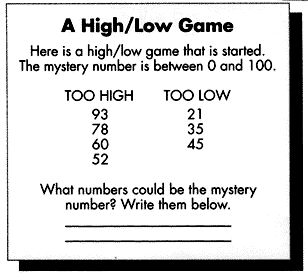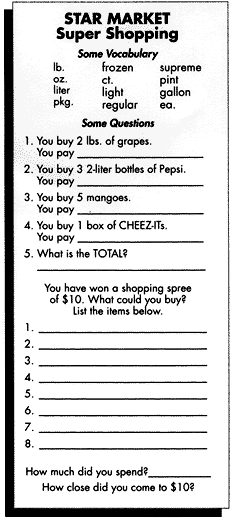
Volume 4, Issue B ::: September 2000
Focus on Teaching: Beginning Math for Beginning Readers
Mathematics actually involves substantial amounts of reading. What do you do if your learners can't yet read?
This framework for a one hour math lesson for beginning readers can also be used with beginning English for speakers of other languages (ESOL) learners who have no formal education.
by Linda Huntington
In the adult basic education program in which I work, we are lucky to have teachers
who have enormous expertise in teaching reading to adult beginning readers. Many
of these learners have learning disabilities. An issue of concern and debate has
been the question of how mathematics fits into this "reading vacuum." Does
it make sense even to teach math, when students need so much direct reading
instruction? And when so much of math involves reading? We have come to the
conclusion that a small amount of math is beneficial even for beginning readers.
Of their six hours of weekly class
instruction, beginning readers in our program receive one hour of math.
I have been teaching the math class for three years. My primary objective for the beginning students is to give them work that will enable them to gain a conceptual sense of how our system of numbers works. I want them to gain accurate estimation skills and an ability to perform basic number operations in their heads, with paper and pencil, or with a calculator. I elicit from them the types of math they encounter in their daily lives and build lessons to reinforce these real-life situations. I try to present number sense activities in ways that are fun, that touch on different learning modalities, and that mirror real-life situations. I hope others working with beginning readers find my methods useful in their own classrooms.
Multilevel Beginners
This year our class includes 11 students: eight men and three women. Two of the 11 have documented learning disabilities (LD). Five of the students are from the United States, five are from the Caribbean, and one is from Ethiopia. Their ages range from late 20s to late 50s. Two of them were originally from our homeless population, and nine are employed. Their educational experiences range from completing four to 12 years of school. One student has a high school diploma. The two students with documented LD were educated in special classroom settings. Because this group of beginning readers has suspected dyslexia, direct instruction and repetition are essential class elements. Progress is measured in small steps.
Dropping out is not much of a problem. Our beginning reader students have exceptional attendance records. Three have had near-perfect attendance each year. Turnover, however, can be an issue. Over the three years that I have been teaching the class, one by one students have progressed to the next level of reading. The movement is slow but steady. As a result, some students have been in the class for more than two years and others are brand new. The difference between the new and the returning students this year is pronounced. The three new students are true beginners in both reading and math. Herein lies the biggest challenge: planning lessons that are accessible to the beginners and at the same time demanding enough for the students with more skills. It is a problem not unique to beginning classes, or to math classes. In this case, however, the issue is compounded by the fact that the students cannot read.
My methods are not earthshaking. I work hard to pair students in such a way that they can help each other. For example, if a student has strong math skills but struggles in reading, I try to partner him or her with a more competent reader whose math skills might be a bit shaky. This way each student can feel good about his or her area of strength. In addition, I always make manipulatives such as pennies, beans, or small blocks available for the students who need them when working out basic math facts. In addition, I teach all the students how to use four-function calculators as tools to help with their computation.
Strict Routine
Since the time devoted to math each week is so short, a strict routine is essential. I want the students to get the maximum out of each class. The most important reason for predictability is that it enables the students to feel more secure and in control of their learning. They know what to expect next and they are therefore less anxious about their abilities. As students begin to internalize the routine, they waste less time figuring out what to do and they learn more. Students who have learning disabilities particularly benefit from routines and consistency.
I begin each class with a warm-up activity, lasting anywhere from ten to 20 minutes. Sometimes the warm up is used for reviewing concepts. These short activities provide me a quick assessment of how "on target" each student is for that day.
One of my favorite warm ups is a game I call High/Low. I came up with this game by combining an activity called "Number Guess" from Family Math (Stenmark, Thompson, & Cossey, 1986, p. 29), with a game I used to play with my daughter, Laura, during family trips when she was in elementary school. The game is a simple number-guessing game: students try to guess a "mystery number" and are given clues as to whether their guesses are too high or too low. We set limits beforehand as to how high the mystery number can be. This activity gives me insight into whether or not the students can count and understand number patterns. Students who win get to pick the next number. My students really enjoy this level of competition. They love to win, but they also help each other when someone is stuck. Winning means you must give the clues to the class, and giving the too-high or too-low clues can be a challenge for many students.
High/low just keeps evolving. I have developed simple worksheets for class or for homework that go with the game (see the sample on this page). Recently I added a new twist: When only a few numbers are left - for example, when 50 is too high and 42 is too low - I stop the guessing for a minute and ask everyone to write all the numbers that could possibly be the mystery number. This helps to focus them on the idea of counting between two specific numbers. Then I ask them to circle the number they think is the right number and we go back to guessing until the correct number is finally picked.
Quick Drill
I usually follow warm-up activities with some kind of quick drill. This part of the lesson varies in format and can include a short worksheet, calculator practice, a round robin or skip counting practice, drawing number patterns on a hundreds chart, flash card rotations, bingo games, following directions, or other games involving number facts. On occasion, the class drill involves math vocabulary and spelling practice. Two of the class's favorite games, "Target Addition" and "The Sum What Dice Game," come directly from the book Family Math (pp. 32, 37). Some of the students have memorized the basic number facts (addition and subtraction families up to 10 + 10, multiplication tables up to 10 x 10); others have not, and may never. Nonetheless, a certain amount of rote drill helps to trigger the students' memories.

The third component of every class is the main lesson. I rely on real-life materials whenever possible. Much of our problem solving involves what can be loosely termed household or consumer math. For example, I bring in enough flyers from the supermarket for the class to use in pairs. We review grocery store vocabulary. They discuss the words used when buying certain products: pound, roll, pack, tub, box, bag, can, jar. Everyone writes these words on their paper while I write them on the board. These might show up later in a bingo game. Next they work, usually in the same pairs, on a worksheet that asks them to find the price of a specific item. They might be trying to spend a given amount of money or no more than a given amount. They might have a grocery list with products to find; then they figure the total bill. Maybe they have won a $500 shopping spree. The possibilities for math are great. I sometimes ask them to calculate the correct change, sometimes I bring in coupons to use, or I might ask them to write their own questions using the information on the flyer. The key point is not to ask too much in any one class, and to repeat the exercise, with small changes, over several weeks. See the next page for an example of one such supermarket worksheet that goes with a supermarket flyer.
Many of the math classes with beginning readers do not strictly follow this three-part model. Occasionally we get sidetracked and take a longer time with the warm-up or on drill. In the end, some classes may include only parts one and three; others, only one and two, or two and three. All this must be accomplished without relying on reading.

Talking about Numbers
Instead, we do lots of talking about numbers. For example, before beginning a unit on shopping, we discuss the techniques the students have for checking their change or for getting the best buy. We might share ideas about using coupons or where to shop. I want to give the students enough self-confidence so that they never need to feel scared of numbers or math. In fact, they already have developed sound number sense through living their daily lives: from shopping, working, traveling, raising their children, and managing their time. Our math class is designed so that the students gain awareness of the math skills they already possess and learn how best to use them.
References
Stenmark, J., Thompson,V., & Cossey, R. (1986) Family Math. Berkeley, CA: Lawrence Hall of Science, the Regents, University of California.
About the Author
Linda Huntington has been teaching math at the Community Learning Center in Cambridge, MA, for more than 12 years. She has taught mathematics at many levels including beginning adult basic education, English for speakers of other languages, General Educational Development test preparation, and post high school.


 Printer-friendly page
Printer-friendly page